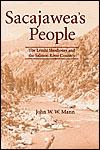book
Sacajawea's People: The Lemhi Shoshones and the Salmon River Country
by John W.W. Mann '01 :: University of Nebraska Press :: Reviewed by Kathie Meyer '92

In this year of 2005, the bicentennial of the Lewis and Clark Expedition, we are again reminded of the role Sacajawea played in that long journey westward. However, Sacajawea's tribe of origin, the Lemhi, has gone largely ignored. Only recently have historians given any significance to what Native American history offers us past the late 19th century. It's this oversight that John W.W. Mann ('01 Ph.D. Hist.) addresses regarding the Lemhi tribe's heroic struggle to maintain its separate ancestry, cultural heritage, and identity during the 20th century in Sacajawea's People: The Lemhi Shoshones and the Salmon River Country.
It is, frankly, an excruciating and confusing tale of bureaucratic warfare. To be brief, on February 12, 1875, President Grant established a reservation for the Lemhi people, a move that met with an immediate and successful effort of rescindment. Shoshone, Bannock, and Lemhi tribal leaders had signed the Fort Bridger Treaty in 1868; however, authorities failed to recognize the Lemhi as a separate people with their own culture. A treaty granting the Lemhi a reservation of their own went unratified in the U.S. Senate. At the crux of the matter was the threat of displacement of the Lemhi to the Fort Hall reservation near Pocatello, Idaho, occupied by the Shoshone and Bannock tribes, with whom the Lemhi had little in common culturally. Chief Tendoy forestalled the inevitable until 1906, but finally signed an agreement to remove his tribe to Fort Hall in exchange for $4,000 annually for 20 years.
Although the government paid a portion of the monies owed, it did not live up to its full promise. Tendoy's successors, Toopompey and Wince, unsuccessfully pursued collection of what remained in government coffers. Later, when Fort Hall residents approved a constitution under the Indian Reorganization Act of 1934, the Shoshone-Bannock Tribal Council became the official decision-making body for all reservation residents regardless of tribal origin. Now the council had the power to decide who could claim any money collected from the government by reservation residents even though, paradoxically, the Lemhi had a legal right to the money as their own.
It is never clear in the telling of this story how much money was eventually collected and which payments resolved which litigation process. In addition to the annuities owed under the removal agreement, the Lemhi also fought for fiscal settlements regarding aboriginal land wrongfully seized and their fishing rights in the Salmon River country.
To bring the story up to the present, the Lemhi recently presented a petition to the Branch of Acknowledgement and Recognition (BAR) of the Bureau of Indian Affairs to restore their recognition by the federal government as a tribe. However, the BAR has restored recognition to a mere eight of the 105 groups that have submitted petitions. Even then, although the BAR recognized the Duwamish tribe of Seattle during the Clinton administration, the Bush administration rescinded the decision.
Sacajawea's People is a difficult read, especially in its recounting of the Lemhi's litigious history, and would have been better served with a timeline to help readers keep track of the chronology. Nonetheless, it's a much-needed account of the historical clash between a government based on European ideas and a small tribe clinging tenaciously to its culture, identity, and sense of place. Mann should be commended for relating a story that is just as hard fought as the journey aided by Sacajawea 200 years ago.